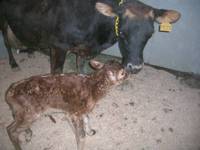Example 1:

"Immediately after the delivery, a cow will get up and begin to call a low
and short "moo" to her calf to encourage it to get moving. She will
vigorously lick it all over to clean the membranes off it and this also puts
her scent all over it. Licking it dries the calf nearly as well as rubbing
a towel all over it! A good mama cow will have her calf trying to stand
within a few minutes of birth. By licking it all over, she gets the
circulation going and the calf starts to recognize her calls as well.
Nature is an amazing thing, as the wobbly calf will immediately head toward
the cow looking for milk." (from a blogger from Kansas)
We may wonder how the calf knows to stand up and look
for milk, clearly an innate skill. As analogy, we can think
of the calf as carrying an instruction manual in genes and then in the head.
We can imagine it as being somewhat like a cookbook - 'The Joy of Walking
and Feeding'.
Next, we note the cow licking and mooing to the calf. We
can see this as skills by the cow that are complementary to the standing,
walking, and feeding skills of the calf. The mooing and licking send
information to the calf that may play a role in invoking the standing, walking, and
feeding skills.
Question 1: What innate information is required to allow the calf to stand up and walk to its mother to feed?
Question 2: How is this innate information inherited from the male and female parents, combined, and passed on to be converted into action?
Question 3: How many innate skills are passed, and how are they compressed to fit into limited space, whether in genes or in the brain?
Question 4: How is the innate information adapted to local circumstances such as being on a slope? More generally, how is perception integrated?
Question 5: How is the innate information and the requisite information processing capability stored in the brain? All in hardware (neurons), or as a mix of hardware and software (memory)?
Short answer 1: Neural information to control muscle tension around the joints. Changes in joint angles that are coordinated in time accomplish the actions.
Short answer 2: The joint-angle change and timing information must mixed from both parents and encoded in the genes of the offspring. This information must then be mapped into the brain and utilized to produce the action.
Short answer 3: The information processing approach used for this investigation does not help to estimate the number of innate skills, but it can be used to explore methods of compression. An 'inner language' is proposed that allows the reuse of core skill components in assembling more complex skills and thus compressing the information.
Short answer 4: Perception of gravity must produce information that modifies the joint-angle change and timing information. For perception in general, the 'inner language' is being explored to provide mechanisms such as conditionals and variables.
Short answer 5: The present research does not address that question. From an information processing perspective, hardwired implementations can be equivalent to implementations based on stored instruction architectures.